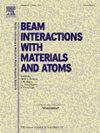Atmospheric pollution derived from PM2.5 particles produced in fireworks burning events in Mexico City
IF 1.4
3区 物理与天体物理
Q3 INSTRUMENTS & INSTRUMENTATION
Nuclear Instruments & Methods in Physics Research Section B-beam Interactions With Materials and Atoms
Pub Date : 2025-05-05
DOI:10.1016/j.nimb.2025.165699
引用次数: 0
Abstract
Fireworks (FW) burnings have attracted the attention of the scientific community because of the potential risks they pose to the environment and human health. In the Mexico City Metropolitan Area (MCMA) and in its surroundings, FW burnings are displayed during local celebrations, depositing large amounts of smoke and fine particles into the atmosphere. That is the case of Christmas and New Year’s Eve celebrations, when FW are sequentially displayed in many countries around the world according to their time zones, causing a global effect. In this study, PM2.5 samples were collected simultaneously from seven strategic sampling sites in the MCMA during Christmas and New Year’s Eve from 2005 to 2010, when FW burning events occurred, and most of the mass concentrations exceeded by a factor of 2–3 times the Mexican Air Quality Standard (NOM) of 65 μg/m3 in 24 h (value level at the time of sampling). A set of 77 samples were analyzed by Particle induced X-ray emission (PIXE) to determine their elemental concentrations. Fifteen elements (S, Cl, K, Ca, Ti, V, Cr, Mn, Fe, Cu, Zn, As, Br, Ba, Pb) were identified in the samples, six of them (Cl, K, Ca, Cr, Cu, Ba) with high concentrations in comparison to samples collected during normal days, when no pyrotechnics were displayed. Ba was found with very high concentrations during these events in comparison with ordinary days, when it barely reached its minimum detection limit. So, it was recognized as the best FW tracer for this study. Several pairs of elements showed good correlations in most of the years under study, which allowed us to infer the presence of some characteristic chemical compounds of the gunpowder used locally.
墨西哥城燃放烟花活动产生的PM2.5颗粒造成的大气污染
烟花(FW)燃烧引起了科学界的关注,因为它们对环境和人类健康构成潜在风险。在墨西哥城大都会区(MCMA)及其周边地区,在当地的庆祝活动中展示了FW燃烧,将大量的烟雾和细颗粒沉积到大气中。这就是圣诞节和新年前夜庆祝活动的情况,当世界上许多国家根据他们的时区顺序显示FW时,造成全球效应。本研究在2005 - 2010年圣诞节和新年期间,在MCMA的7个重点采样点同时采集PM2.5样本,其中大部分在24 h内的质量浓度超过了墨西哥空气质量标准(NOM) 65 μg/m3(采样时的值水平)的2-3倍。采用粒子诱导x射线发射(PIXE)法测定了77个样品的元素浓度。样品中鉴定出15种元素(S、Cl、K、Ca、Ti、V、Cr、Mn、Fe、Cu、Zn、As、Br、Ba、Pb),其中6种元素(Cl、K、Ca、Cr、Cu、Ba)的浓度高于正常情况下没有烟火的样品。与平日相比,在这些事件中发现Ba的浓度非常高,仅达到最低检测限。因此,它被认为是本研究中最好的FW示踪剂。在研究的大多数年份里,有几对元素表现出良好的相关性,这使我们能够推断出当地使用的火药中存在一些特征化合物。
本文章由计算机程序翻译,如有差异,请以英文原文为准。
求助全文
约1分钟内获得全文
求助全文
来源期刊
CiteScore
2.80
自引率
7.70%
发文量
231
审稿时长
1.9 months
期刊介绍:
Section B of Nuclear Instruments and Methods in Physics Research covers all aspects of the interaction of energetic beams with atoms, molecules and aggregate forms of matter. This includes ion beam analysis and ion beam modification of materials as well as basic data of importance for these studies. Topics of general interest include: atomic collisions in solids, particle channelling, all aspects of collision cascades, the modification of materials by energetic beams, ion implantation, irradiation - induced changes in materials, the physics and chemistry of beam interactions and the analysis of materials by all forms of energetic radiation. Modification by ion, laser and electron beams for the study of electronic materials, metals, ceramics, insulators, polymers and other important and new materials systems are included. Related studies, such as the application of ion beam analysis to biological, archaeological and geological samples as well as applications to solve problems in planetary science are also welcome. Energetic beams of interest include atomic and molecular ions, neutrons, positrons and muons, plasmas directed at surfaces, electron and photon beams, including laser treated surfaces and studies of solids by photon radiation from rotating anodes, synchrotrons, etc. In addition, the interaction between various forms of radiation and radiation-induced deposition processes are relevant.

 求助内容:
求助内容: 应助结果提醒方式:
应助结果提醒方式:


